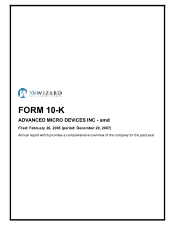AMD 2007 Annual Report Download - page 9
Download and view the complete annual report
Please find page 9 of the 2007 AMD annual report below. You can navigate through the pages in the report by either clicking on the pages listed below, or by using the keyword search tool below to find specific information within the annual report.
Table of Contents
Microprocessor Products
We currently offer single-core and multi-core microprocessor products for servers, workstations, notebooks and desktop PCs. Our microprocessors
currently are designed with both 32-bit and 64-bit processing capabilities. We based our microprocessors on the x86 instruction set architecture and most of these
processors are also based on the AMD64 technology platform with Direct Connect Architecture. The AMD64 technology platform extends the industry-standard
x86 instruction set architecture to 64-bit computing. Direct Connect Architecture connects an on-chip memory controller and input/output, or I/O, channels
directly to one or more microprocessor cores. For multi-core microprocessors, we integrate two or more processor cores onto a single die and each core has its
own dedicated cache, which is memory that is located on the semiconductor die, permitting quicker access to frequently used data and instructions. Some of our
microprocessors have additional levels of cache such as L2, or second level cache, and L3, or third level cache, to enable faster data access and higher
performance. We believe this architecture, and the integrated memory controller in particular, enables substantially higher performance than traditional front-side
bus architectures because memory can be accessed more directly, resulting in increased bandwidth and reduced memory latencies.
Our processors support HyperTransport™ technology, which is a high-bandwidth communications interface that enables substantially higher
multi-processor performance and scalability than competing x86 architectures. In designing our processors, we also focus on continuously improving power
management technology, or “performance-per-watt.” To that end, we offer processors that feature AMD PowerNow! ™ technology, which we designed to reduce
system level energy consumption, with multiple levels of lower clock speed and voltage states that can significantly reduce processor power consumption during
idle times. We design our microprocessors to be compatible with operating system software such as the Microsoft® Windows® family of operating systems,
Linux®, NetWare®, Solaris and UNIX. We also designed the AMD64 architecture to enhance the security of a user’s computing environment by integrating
security features that are designed to prevent the spread of certain viruses when enabled by the anti-virus features of current versions of certain operating
systems, including Linux, the Microsoft® Windows® family of operating systems and Solaris operating systems.
Servers and Workstation Microprocessors. Our microprocessors for servers and workstations consist primarily of our quad-core, dual-core and
single-core AMD Opteron™ processors. A server is a device that performs services for connected clients as part of a client-server architecture. They are designed
to run an application or applications, often for extended periods of time with minimal human direction. Examples of servers include web servers, e-mail servers,
and file servers. A workstation is essentially a high-end desktop, designed for technical applications such as computer-aided design and digital content creation.
Workstations usually offer higher performance than is normally seen on a personal computer, especially with respect to graphics, processing power, memory
capacity and multitasking activity.
We based our AMD Opteron processors for servers and workstations on our Direct Connect Architecture and the AMD64 technology platform, and
designed them to allow simultaneous 32-bit and 64-bit computing. These processors can be used in a variety of server applications, including business processing
(enterprise resource planning, customer relationship management, and supply chain management) and business intelligence. They can also be used in workstation
applications such as engineering and digital content creation software and other information technology infrastructure applications such as intensive Web serving
and messaging.
Our multi-core AMD Opteron processors offer improved overall performance on many applications compared to single-core AMD processors by
executing more operations simultaneously during each clock cycle, and by improving performance-per-watt, which can reduce the operational costs related to
power usage. At the same time, servers based on multi-core AMD Opteron processors are easier to manage because more processing capacity can be
concentrated into fewer servers. For this reason, servers based on multi-core processors are less costly to operate.
Multi-core AMD Opteron processors also allow our enterprise customers to more easily implement virtualization across their businesses. Virtualization is
the use of software to allow multiple discrete operating
4
Source: ADVANCED MICRO DEVIC, 10-K, February 26, 2008






















